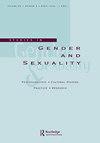自我(即)-识别:真实性,传递和跨具体化的想象
Q3 Social Sciences
引用次数: 0
摘要
摘要作为跨性别者出现,意味着对被故意抛弃的物体和幻觉的忧郁、矛盾的丧失。为自己的性别表达创造替代性幻想,需要在试图在镜子中看到自己真实的内心真相(自我识别)和寻求与外部识别相关的肯定和安全(通常被称为通过)之间找到紧张关系。向霸权的二元性别规范致敬可以提高一个人的可读性,但可能会因为真实自我的消失而削弱自我认知和与他人建立亲密联系的能力。这对非二元个体来说尤其突出,对他们来说,通过考试需要选择一种危害最小的误认形式。我在民族志采访中探讨了这些主题,采访了28名变性人、非双性人和/或性别膨胀的人。参与者(二元和非二元)绝大多数都幻想自己的面部特征与出生时指定的性别更不一致(例如,出生时指定女性寻找棱角分明的下巴和颧骨)。他们发现,在他们的脸上存在这样的元素,肯定或想象没有这些元素会导致错误识别。矛盾的是,当这种超男性气质或超女性气质被数字滤镜投射到他们的脸上时,这些人并不满意,因为他们失去了自我识别能力。本文章由计算机程序翻译,如有差异,请以英文原文为准。
Self(ie)-Recognition: Authenticity, Passing, and Trans Embodied Imaginaries
ABSTRACT Coming out as trans involves the melancholic, ambivalent loss of intentionally forsaken objects and illusions. Creating replacement fantasies for one’s gender expression requires navigating tensions between trying to visualize one’s authentic internal truth in the mirror (self-recognition) and seeking the affirmation and safety associated with external recognition, often referred to as passing. Ascribing to hegemonic binary gender norms can increase one’s legibility, but may impair self-recognition and one’s ability to form intimate connections with others, due to erasure of the authentic self. This can be particularly salient for nonbinary individuals, for whom passing necessitates choosing a least harmful form of misrecognition. I explored these themes in ethnographic interviews with 28 transgender, nonbinary, and/or gender-expansive individuals about their faces. Participants (binary and nonbinary) overwhelmingly fantasized about having facial features more stereotypically incongruent with their assigned-gender-at-birth (e.g., assigned-female-at-birth seeking angular jaw and cheekbones). They found the presence of such elements in their faces affirming or imagined a lack thereof to promote misrecognition. Paradoxically, these same persons were dissatisfied when such hypermasculinity or hyperfemininity was projected onto their faces by digital filters, due to loss of self-recognition.
求助全文
通过发布文献求助,成功后即可免费获取论文全文。
去求助
来源期刊

Studies in Gender and Sexuality
Social Sciences-Gender Studies
CiteScore
0.80
自引率
0.00%
发文量
15
期刊介绍:
Beginning in the final two decades of the 20th century, the study of gender and sexuality has been revived from a variety of directions: the traditions of feminist scholarship, postclassical and postmodern psychoanalytic theory, developmental research, and cultural studies have all contributed to renewed fascination with those powerfully formative aspects of subjectivity that fall within the rubric of "gender" and "sexuality." Clinicians, for their part, have returned to gender and sexuality with heightened sensitivity to the role of these constructs in the treatment situation, including the richly variegated ways in which assumptions about gender and sexuality enter into our understandings of "normality" and "pathology."
 求助内容:
求助内容: 应助结果提醒方式:
应助结果提醒方式:


